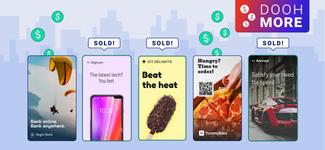When discussing out-of-home (OOH) advertising, the focus often shifts to comparing the benefits of static and digital OOH. However, both offer distinct advantages for advertisers. Digital OOH (DOOH) provides advertisers with more flexibility and agility, while static offers eye-catching large formats and a 100% share of voice. Moreover, while DOOH accounts for 67.1% of total OOH spend, static still represents about 70% of today’s inventory. Therefore, the focus shouldn’t be on prioritizing one over the other, but rather on how we can effectively integrate both formats to create impactful campaigns.
A lot of media owners already share this sentiment, as many with static inventory are actively integrating digitization into their core strategies. In fact, Broadsign’s State of Static OOH report highlights that more than two-thirds (69%) of static media owners surveyed classified their networks as “hybrid”, meaning they offer both static and digital inventory.
Moreover, nearly 43% of survey respondents stated that they plan on investing in digitizing existing static faces in the next one to two years. With the number of hybrid networks only expected to grow, a solution that will streamline and consolidate the campaign planning and booking process for both static and digital OOH is fundamental.
The need for a seamless campaign planning process for hybrid networks
While significant advancements have been made in the last few years to campaign planning for DOOH, booking a static OOH campaign remains a manual and lengthy process. 53% of static media owners surveyed in the State of Static OOH report feel that operational efficiencies are putting them at a competitive disadvantage.
More specifically, 74% found the campaign planning process (tracking inventory availability and proposal management) to be the area of static OOH management that gives them the most headaches. For hybrid networks, the process is further complicated by having to manage two separate workflows for digital and static OOH inventory.
The demand for a solution that seamlessly handles both digital and static OOH is becoming more pronounced. Over 68% of surveyed static media owners recognize the importance of managing their digital and static OOH assets within a single, integrated platform. Furthermore, features like real-time inventory availability and proposal building are some of the top features that companies look for in a static OOH management tool.
Enter Broadsign’s new unified campaign planning workflow
For media owners seeking a more seamless and unified approach to campaign planning, Broadsign’s new capability is just right. Unlike legacy OOH workflows that separate static and digital bookings into distinct systems, users can now plan and book static and digital inventory in one proposal in the Broadsign Platform, increasing efficiency and operational flexibility while enhancing the buying experience for OOH.
Streamlined and simplified proposal management
Broadsign’s unified approach provides users with significant time savings. When planning a campaign in the platform, you can now manage all inventory types without needing to switch between modules. Moreover, building a unified proposal for both static and DOOH not only reduces your team’s administrative workload but also minimizes the risk of mistakes.
Media buyers also benefit from the unified proposal, as they’ll no longer receive two separate proposals when booking a multi-format OOH campaign. This especially simplifies campaign planning for omnichannel buyers who often have to review and manage proposals for other channels.
More flexibility in your booking and selling strategy
Broadsign’s unified campaign planning workflow maximizes inventory utilization and increases incremental revenue by enabling premium pricing for tailored and targeted campaigns. By seamlessly mixing and matching static and digital inventory, you can more effectively meet campaign objectives while ensuring that your hybrid network is optimally filled.
The unified workflow also allows for direct audience data uploads for static campaigns within the platform and access to new targeting tools for digital campaigns, such as Maps and Point-of-Interest (POI) uploads—all within a single campaign. These enhanced targeting capabilities empower you to create performance-driven campaigns that meet advertiser expectations from the get-go, positioning your inventory as premium and more impactful than competing OOH networks.
Bridging the gap between OOH and other channels for advertisers
While the new campaign planning capabilities are only an initial step in Broadsign’s efforts to unify digital and static OOH workflows, this represents a significant leap forward for the industry. The simplified and streamlined approach to booking and planning OOH campaigns, regardless of whether it’s static or digital inventory, can make OOH more appealing to a wider range of buyers. It can also reduce the learning curve for new buyers, encouraging a broader adoption of the medium.
Finally, this latest enhancement to the Broadsign Platform is not only a step closer to the company’s long-term vision of delivering a comprehensive end-to-end platform that seamlessly supports digital, static and programmatic sales, but also levels the playing field for OOH with other channels. By embracing a more flexible and agile approach to campaign planning, OOH can better compete with channels that traditionally provide greater adaptability and real-time responsiveness to buyers.






